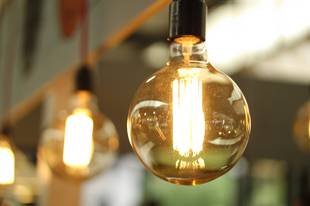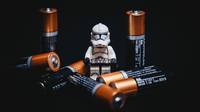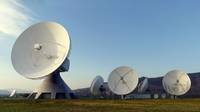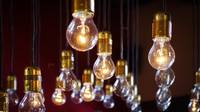
At the most basic level, light bulbs or incandescent lights work by exciting atoms that release photons of light. Not all photons emit visible light, however. In fact because of the way light bulbs work, most of the radiation is emitted as heat rather than visible light. For this reason light bulbs are not very efficient generators of light by today's standards.
The modern light bulb is a thin, glass chamber filled with inert gases, usually argon. Two metal rods extend upwards into the chamber from contacts at the base of the bulb. A filament of tungsten connects the rods. Tungsten is a key element to the way light bulbs work because it has very high melting temperature. When electricity is applied to the bulb, it passes through the contacts, rods, and connecting filament, exciting atoms in the tungsten that generate photons.
Excited atoms vibrate. Over time, the tungsten filament weakens as individual atoms vibrate free of the filament. This is an area where one improvement has been made in the way light bulbs work. Bulbs did not contain inert gasses originally, but vacuum which did nothing to prevent the filament from losing atoms. Inert gasses help to extend the life of the filament by providing "bumper" atoms to help knock atoms back into the filament as they escape. The way light bulbs work now is slightly more efficient than the original vacuum design.
Fluorescent lights have a different design that is more efficient than the way light bulbs work. Fluorescent lights run cooler, waste very little energy and generally last six to ten times longer than incandescent light bulbs.
Fluorescent lights are tubular in desmign with capped ends that feature two external pins each. The inside of the glass tube is powder-coated with phophorous. A small drop of mercury is also placed inside the bulb, which is filled with argon gas. An electrode at either end connects to electrical circuits.
A basic understanding of how light is produced is helpful. Atoms have negatively charged electrons orbiting the nucleus at various distances. When an atom absorbs enough energy it can cause one of the electrons to jump to a higher orbit. As the electron loses energy, it falls back to its previous orbit. When it does so, it emits a photon of light. The key in producing light then, is in exciting atoms enough to knock electrons from their orbits.
When electricity flows through the electrodes in fluorescent lights, it produces a charge that causes free electrons to travel through the gas-filled tube from one electrode to the other. This energy vaporizes a small portion of the mercury inside the tube. Electrons and ions (charged atoms) collide with gaseous mercury atoms, which in turn release ultraviolet (UV) photons.
As we cannot see UV light, there is one more step in the elaborate design of fluorescent lights. The key is in the phosphorous coating that lines the inner glass tube. When phosphor is exposed to UV light, it absorbs the energy and radiates it back out as visible white light. This is wasted as lost heat in a light bulb is transformed into visible light in fluorescent lights.
Older fluorescent lights used a starter switch mechanism that sometimes took a minute or so to fully ionize the gas. In the interim the light would flicker. Today's fluorescent lights are rapid start. The ionizing trigger is built into the ballast, which is the small device that controls the electrical current that feeds the electrodes.


















